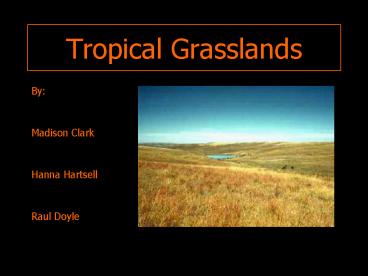Tropical Grasslands PowerPoint PPT Presentation
Title: Tropical Grasslands
1
Tropical Grasslands
- By
- Madison Clark
- Hanna Hartsell
- Raul Doyle
2
Plants
- Plants in the tropical grasslands generally must
be able to withstand the dry season. Many have
long tap roots to reach underground water. - Thick bark is often present as a defense against
fire. Trunks may be able to store water, and
leaves are dropped during the dry season to
conserve water. Storage organs, such as bulbs,
can also help plants survive the drought.
3
Bermuda Grass
- Bermuda grass is a specific species that has
adapted to thrive throughout disturbances such as
fire, drought, flooding, and grazing--all common
aspects of the tropical grasslands. It is a
creeping grass that forms a mat on top of the
ground. - A deep root system allows the grass to have
better access to water in dry conditions. The
roots can be up to 59 inches deep. Bermuda grass
produces seeds for reproduction 3 months after
planting, which allows for quick reproduction. - The seeds germinate in temperatures above 68
degrees, which is ideal for life in the tropical
grasslands. It's ability to grow in poor soil
also allows this grass to survive in the savanna.
During the dry season, this grass is able to have
its upper parts die but it still grows
underground.
4
Animals
- Animals must have several adaptations to live
in the tropical grasslands. Many have long legs
or wings to aid in migration. Others burrow to
escape the heat. Large ears or surfaces of
skin allow the animals to lose heat to
the environment. To avoid competition among the
various species, each has developed its own
feeding preference. Animals eat vegetation at
different heights or times and migrate to
different places during the dry season. - Tropical grasslands are full of life. In the
savanna, insect populations are very high.
Insects like termites and even locusts, number in
the billions. What is more amazing is the variety
of animals that live in the savanna - Predators need to be quick, powerful, smart, and
sneaky to bring down fast and alert animals, like
gazelles.
5
Cheetahs Hyenas
- Cheetahs, for instance, are built to move fast.
These animals can reach speeds of up to 80 miles
an hour (129 kilometers per hour). Other savanna
predators, like lions, sneak up on their prey.
Sometimes they will hunt with their pride and
ambush unsuspecting prey. - Hyenas and Australian dingoes also hunt in
groups. These animals are also scavengers.
6
Location
- Tropical grasslands, or savannas, lie north and
south of tropical rain forests that are on the
equator. - Some areas beyond savannas are hot deserts. Other
savannas may be lined with mountains, dense
forests, and seas. - South America is home to several large savannas.
An example of one of these savannas is the
llanos, which means plains, located in the
Orinoco River basin. - The llanos is north of the Amazon forests and is
shared in areas of Columbia and Venezuela. It is
the size of France or Texas. - Another large tropical grassland can be found
south of the Amazon forest in the Brazilian
Highlands, called Campos. Other South American
grasslands can be found in southeast Venezuela
and southern Guyana.
7
Climate
- Plants usually start growing when the daily
temperature reached about 50 F - Tropical grasslands experience hot weather in
every season. In the winter, it can be a rainless
and relatively hot season. Temperatures can be
well over 64 F (18 C) during the winter. - The summer, is considered the rainy season. Rain
clouds form over the savanna as warm, moist air
arrives from the equator. The temperatures remain
above 80 F (27 C). - Savannas that have warm and dry winters and hot,
rainy summers are called monsoon climates.
Monsoon comes from the Arabic word mauism,
meaning season. Monsoon climates experience winds
that go in different directions at different
times of the year. - Although most tropical grasslands are located in
the tropics, precipitation in savannas can
greatly vary. For instance, some Australian
savannas receive only 18 inches (46 centimeters)
a year, while African savannas can receive more
than three times that.
8
Biomass
- Biomass is the dry weight of all organic matter
contained in its organisms. Productivity is the
rate at which producers convert solar energy into
chemical energy as biomass. The soil contains
very few nutrients. Plants must be able to
withstand drought in order to be productive.
Productivity is higher during the rainy season,
so this makes the average net productivity
higher. - This biome has low to moderate rain (30-40
inches). No rain falls at all between December
February. Its drought season is in
the winter and its rainy season in the summer.
The monsoon season typically starts in
May. Temperatures range between 60-80 degrees
Fahrenheit year-round. It is considered part of
the tropical wet/dry climate zone.

